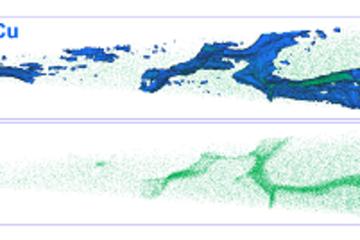All genres
381.
Talk
Combining ab initio calculations and high-resolution experiments to understand advanced Mg alloys. German-Korean workshop on the “Production and industrial applications of semi-finished Mg products”, Irsee, Germany (2011)
382.
Talk
The effect of texture on the stability of retained austenite in Al-alloyed TRIP steels of Al-alloyed TRIP Steels. MRS 2010 Fall Meeting, Boston, MA, USA (2010)
383.
Talk
Statistical Reliability of EBSD Data Sets for the Characterization of Al-alloyed TRIP Steels. 15th International Metallurgy and Materials Congress, Istanbul, Turkey (2010)
384.
Talk
Crystal mechanics of the martensitic transformation: Crystal plasticity, ab initio models, experiments. Colloquium Lecture, Institute for Mechanics, University of Dortmund, Dortmund, Germany (2010)
385.
Talk
Effect of RE elements on the deformation and recrystallization behaviour of Magnesium. MagNET Workshop 5, Vancouver, Canada (2010)
386.
Talk
Diffraction techniques in the scanning electron microscope: Making SEM a universal tool for microstructure research. Salzgitter-Mannesmann Summerschool, Duisburg, Germany (2010)
387.
Talk
Relation between damage nucleation and microstructure in TRIP steels. Materials Science and Engineering MSE 2010, Darmstadt, Germany (2010)
388.
Talk
Microstructure Evolution in TWIP steels during deformation with strain path changes. Materials Science and Engineering MSE 2010, Darmstadt, Germany (2010)
389.
Talk
Recrystallization and grain growth in ultra fine grained CuZr alloy processed by high pressure torsion. Materials Science and Engineering MSE 2010, Darmstadt, Germany (2010)
390.
Talk
Deformation, Shear Banding and Ductility in Mg and Mg-Y. Materials Science and Engineering MSE 2010, Darmstadt, Germany (2010)
391.
Talk
Surface Topographies after Nanoindentation and their Utilization to Quantify the Plastic Anisotropy of Gamma-TiAl on the Single Crystal Length Scale. Materials Science and Engineering MSE 2010, Darmstadt, Germany (2010)
392.
Talk
A critical review of orientation microscopy techniques in SEM and TEM. Facets of Electron Crystallography, Berlin, Germany (2010)
393.
Talk
Recrystallization and grain growth in ultra fine grained materials produced by high pressure torsion. Recrystallization & Grain Growth 4 RX&GG, Sheffield, UK (2010)
394.
Talk
Microstructure evolution during recrystallization of dual-phase steels. Recrystallization & Grain Growth 4, Sheffield, UK (2010)
395.
Talk
3D EBSD: Tomographic orientation microscopy in a FIB SEM. E-MRS 2010 Spring Meeting, Strasbourg, France (2010)
396.
Talk
3D orientation microscopy based on FIB-EBSD tomography: Potentials and limits. Advanced Methods in Electron Backscatter Diffraction, St. Etienne, France (2010)
397.
Talk
Statistical Reliability of Phase Fraction and Texture Determination Based on EBSD Investigations on the Example of an Al-TRIP steel. Royal Microscopy Society (RMS) EBSD 2010 Meeting, Derby, UK (2010)
398.
Talk
Improving the physical resolution of electron backscatter diffraction by decreasing accelerating voltage. EBSD 2010 Meeting, Rolls-Royce Leisure Association, Derby, UK (2010)
399.
Talk
Quantitative determination of twin volume fraction in TWIP steels by high resolution EBSD. Materials Science and Technology (MS&T) 2010, Pittsburgh, PA, USA (2009)
400.
Talk
Crystal plasticity analysis of nanoindentation in intermetallic gamma-TiAl. Nanomechanical Testing in Materials Research and Development, Barga, Italy (2009)











